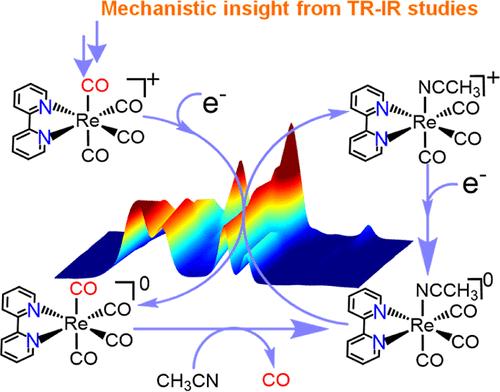在联吡啶铼催化的二氧化碳还原反应中直接检测产物释放过程中的关键中间产物
IF 11.3
1区 化学
Q1 CHEMISTRY, PHYSICAL
引用次数: 0
摘要
在电化学和光化学条件下,联吡啶三羰基铼配合物 fac-[Re(bpy)(CO)3X]n+ 能高效地将 CO2 选择性地转化为 CO。尽管有许多机理研究旨在了解其二氧化碳还原反应(CO2RR)途径,但进入催化循环的中间产物一直未被检测到,而导致产物释放的步骤仍然难以捉摸。在这项研究中,我们采用停流混合法和时间分辨红外光谱法,首次观察到还原的 Re-四羰基物种 [Re(boy)(CO)4]0,其在乙腈溶剂中的半衰期约为 55 毫秒。据推测,这种中间体在电化学和光化学 CO2RR 中都很常见。此外,我们还直接观察到了这一中间产物(CO)的释放。此外,我们还检测到[Re(boy)(CO)3(CH3CN)]+ 作为产物释放后的副产物积累,这是在还原当量供应有限的条件下发生的一个重要副反应,与光化学条件如出一辙。通过同时实时检测所有参与反应的物种,可以明确地将这一过程归因于电子转移催化的配体取代反应,其中涉及 [Re(py)(CO)4]0。我们认为,在光化学条件下或在温和过电位的电催化过程中,这种副反应会极大地影响这类催化剂的 CO2RR 效率。本文章由计算机程序翻译,如有差异,请以英文原文为准。

Direct Detection of Key Intermediates during the Product Release in Rhenium Bipyridine-Catalyzed CO2 Reduction Reaction
Rhenium bipyridine tricarbonyl complexes, fac-[Re(bpy)(CO)3X]n+, are highly effective in selectively converting CO2 to CO under electrochemical and photochemical conditions. Despite numerous mechanistic studies aimed at understanding its CO2 reduction reaction (CO2RR) pathway, the intermediates further into the catalytic cycle have escaped detection, and the steps leading to product release remained elusive. In this study, employing stopped-flow mixing coupled with time-resolved infrared spectroscopy, we observed, for the first time, the reduced Re-tetracarbonyl species, [Re(bpy)(CO)4]0, with a half-life of approximately 55 ms in acetonitrile solvent. This intermediate is proposed to be common in both electrochemical and photochemical CO2RR. Furthermore, we directly observed the release of the product (CO) from this intermediate. Additionally, we detected the accumulation of [Re(bpy)(CO)3(CH3CN)]+ as a byproduct following product release, a significant side reaction under conditions with a limited supply of reducing equivalents mirroring photochemical conditions. The process could be unambiguously attributed to an electron transfer-catalyzed ligand substitution reaction involving [Re(bpy)(CO)4]0 by simultaneous real-time detection of all involved species. We believe that this side reaction significantly impacts the CO2RR efficiency of this class of catalysts under photochemical conditions or during electrocatalysis at mild overpotentials.
求助全文
通过发布文献求助,成功后即可免费获取论文全文。
去求助
来源期刊

ACS Catalysis
CHEMISTRY, PHYSICAL-
CiteScore
20.80
自引率
6.20%
发文量
1253
审稿时长
1.5 months
期刊介绍:
ACS Catalysis is an esteemed journal that publishes original research in the fields of heterogeneous catalysis, molecular catalysis, and biocatalysis. It offers broad coverage across diverse areas such as life sciences, organometallics and synthesis, photochemistry and electrochemistry, drug discovery and synthesis, materials science, environmental protection, polymer discovery and synthesis, and energy and fuels.
The scope of the journal is to showcase innovative work in various aspects of catalysis. This includes new reactions and novel synthetic approaches utilizing known catalysts, the discovery or modification of new catalysts, elucidation of catalytic mechanisms through cutting-edge investigations, practical enhancements of existing processes, as well as conceptual advances in the field. Contributions to ACS Catalysis can encompass both experimental and theoretical research focused on catalytic molecules, macromolecules, and materials that exhibit catalytic turnover.
 求助内容:
求助内容: 应助结果提醒方式:
应助结果提醒方式:


